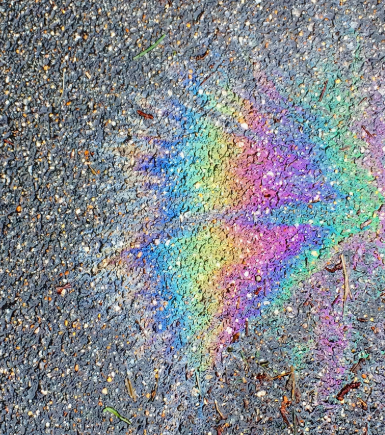Tips for Driving in the Rain
Ok, friends, since we haven't seen wet roads in months, I feel it my duty to share a few tips for driving safely in the rain - in all seriousness. Please share with new drivers especially. Be careful out there!
1. Roads are most dangerous after the first gentle rain. If it's been dry for days or weeks, that's allowed oil, gasoline, and tire residue to build up on the roads. Add a lite covering of rain to those chemicals and traction is DRAMATICALLY reduced. The first rain after an extended dry spell is almost as dangerous as ice on the roads. Drive with great care and brake early.
An “oil rainbow” on asphalt. This is what happens when a lite rain falls after an extended period of dry days. It isn’t strong enough to fully wash the chemicals off the roads, leaving conditions extremely slick.
2. Good tires matter much more in the rain. Those grooves in our tires are pointless in dry weather, but in the wet, are essential for channeling water away from your tires to prevent hydroplaning. The minimum safe depth for those channels is 3/32's of an inch... but who of us has a depth gauge handy! So just grab a penny and stick it in the groove with Abe's head facing down. If you can still see the top of Abe's head, time for a new tire! And remember to check the grooves on the inner, middle, and outer edge of each tire since they can wear differently. Replace when even just one channel becomes too low.
This tire is done. DO NOT DRIVE in the rain on a tire that fails the penny test.
3. Don't ever, ever, ever, ever try to drive through standing water (exception: dedicated off-road vehicles on trails driven by people who know what they're doing). If water gets into your engine or computer systems, your vehicle is likely ruined. And if it's rapidly moving water, it doesn't take much to catch a vehicle in the current and endanger your life. It's never worth it.
This car is probably just seconds away from total, permanent breakdown. If even a little water gets into the engine, it can “hydrolock” causing pistons and rods to break and destroy the block.



